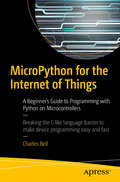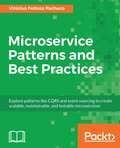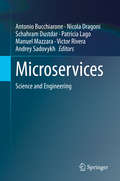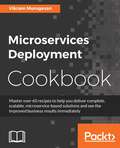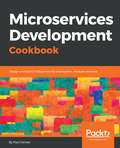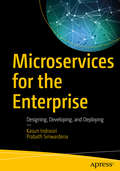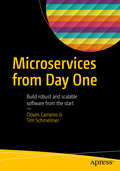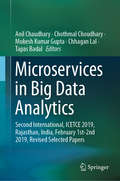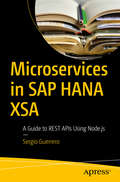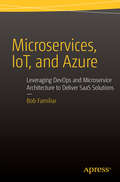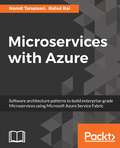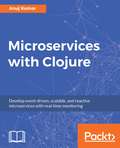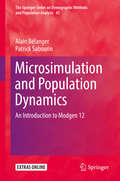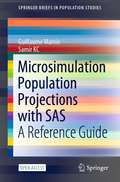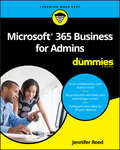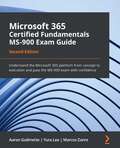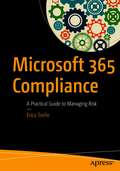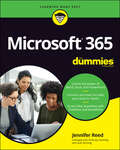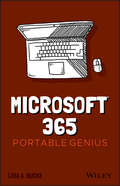- Table View
- List View
MicroPython for the Internet of Things: A Beginner’s Guide to Programming with Python on Microcontrollers
by Charles BellQuickly learn to program for microcontrollers and IoT devices without a lot of study and expense. MicroPython and controllers that support it eliminate the need for programming in a C-like language, making the creation of IoT applications and devices easier and more accessible than ever. MicroPython for the Internet of Things is ideal for readers new to electronics and the world of IoT. Specific examples are provided covering a range of supported devices, sensors, and MicroPython boards such as Pycom’s WiPy modules and MicroPython’s pyboard. Never has programming for microcontrollers been easier.The book takes a practical and hands-on approach without a lot of detours into the depths of theory. The book:Shows a faster and easier way to program microcontrollers and IoT devicesTeaches MicroPython, a variant of one of the most widely used scripting languagesIs friendly and accessible to those new to electronics, with fun example projectsWhat You'll LearnProgram in MicroPythonUnderstand sensors and basic electronicsDevelop your own IoT projectsBuild applications for popular boards such as WiPy and pyboardLoad MicroPython on the ESP8266 and similar boardsInterface with hardware breakout boardsConnect hardware to software through MicroPythonExplore the easy-to-use Adafruit IO connecting your microcontroller to the cloudWho This Book Is ForAnyone interested in building IoT solutions without the heavy burden of programming in C++ or C. The book also appeals to those wanting an easier way to work with hardware than is provided by the Arduino and the Raspberry Pi platforms.
MicroRNA Cancer Regulation: Advanced Concepts, Bioinformatics and Systems Biology Tools (Advances in Experimental Medicine and Biology #774)
by Ulf Schmitz, Olaf Wolkenhauer and Julio VeraThis edited reflects the current state of knowledge about the role of microRNAs in the formation and progression of solid tumours. The main focus lies on computational methods and applications, together with cutting edge experimental techniques that are used to approach all aspects of microRNA regulation in cancer. We are sure that the emergence of high-throughput quantitative techniques will make this integrative approach absolutely necessary in the near future. This book will be a resource for researchers starting out with cancer microRNA research, but is also intended for the experienced researcher who wants to incorporate concepts and tools from systems biology and bioinformatics into his work. Bioinformaticians and modellers are provided with a general perspective on microRNA biology in cancer, and the state-of-the-art in computational microRNA biology.
Microservice Patterns and Best Practices: Explore Patterns Like Cqrs And Event Sourcing To Create Scalable, Maintainable, And Testable Microservices
by Vinicius Feitosa PachecoMicroservices are a hot trend in the development world right now. Many enterprises have adopted this approach to achieve agility and the continuous delivery of applications to gain a competitive advantage. This book will take you through the different design patterns at different stages of the microservice application development process, along with best practices.
Microservices: Science and Engineering
This book describes in contributions by scientists and practitioners the development of scientific concepts, technologies, engineering techniques and tools for a service-based society. The focus is on microservices, i.e cohesive, independent processes deployed in isolation and equipped with dedicated memory persistence tools, which interact via messages.The book is structured in six parts. Part 1 “Opening” analyzes the new (and old) challenges including service design and specification, data integrity, and consistency management and provides the introductory information needed to successfully digest the remaining parts. Part 2 “Migration” discusses the issue of migration from monoliths to microservices and their loosely coupled architecture. Part 3 “Modeling” introduces a catalog and a taxonomy of the most common microservices anti-patterns and identifies common problems. It also explains the concept of RESTful conversations and presents insights from studying and developing two further modeling approaches. Next , Part 4 is dedicated to various aspects of “Development and Deployment”. Part 5 then covers “Applications” of microservices, presenting case studies from Industry 4.0, Netflix, and customized SaaS examples. Eventually, Part 6 focuses on “Education” and reports on experiences made in special programs, both at academic level as a master program course and for practitioners in an industrial training.As only a joint effort between academia and industry can lead to the release of modern paradigm-based programming languages, and subsequently to the deployment of robust and scalable software systems, the book mainly targets researchers in academia and industry who develop tools and applications for microservices.
Microservices Deployment Cookbook
by Vikram Murugesan 1 31 2017Master over 60 recipes to help you deliver complete, scalable, microservice-based solutions and see the improved business results immediatelyAbout This BookAdopt microservices-based architecture and deploy it at scaleBuild your complete microservice architecture using different recipes for different solutionsIdentify specific tools for specific scenarios and deliver immediate business results, correlate use cases, and adopt them in your team and organizationWho This Book Is ForThis book is for developers, ops, and DevOps professionals who would like to put microservices to work and improve products, services, and operations. Those looking to build and deploy microservices will find this book useful, as well as managers and people at CXO level looking to adopt microservices in their organization. Prior knowledge of Java is expected. No prior knowledge of microservices is assumed.What You Will LearnBuild microservices using Spring Boot, Wildfly Swarm, Dropwizard, and SparkJavaContainerize your microservice using DockerDeploy microservices using Mesos/Marathon and KubernetesImplement service discovery and load balancing using Zookeeper, Consul, and NginxMonitor microservices using Graphite and GrafanaWrite stream programs with Kafka Streams and SparkAggregate and manage logs using KafkaGet introduced to DC/OS, Docker Swarm, and YARNIn DetailThis book will help any team or organization understand, deploy, and manage microservices at scale. It is driven by a sample application, helping you gradually build a complete microservice-based ecosystem. Rather than just focusing on writing a microservice, this book addresses various other microservice-related solutions: deployments, clustering, load balancing, logging, streaming, and monitoring.The initial chapters offer insights into how web and enterprise apps can be migrated to scalable microservices. Moving on, you'll see how to Dockerize your application so that it is ready to be shipped and deployed. We will look at how to deploy microservices on Mesos and Marathon and will also deploy microservices on Kubernetes. Next, you will implement service discovery and load balancing for your microservices. We'll also show you how to build asynchronous streaming systems using Kafka Streams and Apache Spark.Finally, we wind up by aggregating your logs in Kafka, creating your own metrics, and monitoring the metrics for the microservice.Style and approachThis book follows a recipe-driven approach and shows you how to plug and play with all the various pieces, putting them together to build a complete scalable microservice ecosystem. You do not need to study the chapters in order, as you can directly refer to the content you need for your situation.
Microservices Development Cookbook: Design And Build Independently Deployable, Modular Services
by Paul OsmanMicroservices is a popular way to build distributed systems that power modern web and mobile apps. Deploying your application as a suite of independently deployable, modular, and scalable services has many benefits. In this book, you'll learn to employ microservices to make your application more fault-tolerant and easier to scale and change.
Microservices for the Enterprise: Designing, Developing, and Deploying
by Kasun Indrasiri Prabath SiriwardenaUnderstand the key challenges and solutions around building microservices in the enterprise application environment. This book provides a comprehensive understanding of microservices architectural principles and how to use microservices in real-world scenarios.Architectural challenges using microservices with service integration and API management are presented and you learn how to eliminate the use of centralized integration products such as the enterprise service bus (ESB) through the use of composite/integration microservices. Concepts in the book are supported with use cases, and emphasis is put on the reality that most of you are implementing in a “brownfield” environment in which you must implement microservices alongside legacy applications with minimal disruption to your business. Microservices for the Enterprise covers state-of-the-art techniques around microservices messaging, service development and description, service discovery, governance, and data management technologies and guides you through the microservices design process. Also included is the importance of organizing services as core versus atomic, composite versus integration, and API versus edge, and how such organization helps to eliminate the use of a central ESB and expose services through an API gateway.What You'll LearnDesign and develop microservices architectures with confidencePut into practice the most modern techniques around messaging technologies Apply the Service Mesh pattern to overcome inter-service communication challengesApply battle-tested microservices security patterns to address real-world scenariosHandle API management, decentralized data management, and observabilityWho This Book Is ForDevelopers and DevOps engineers responsible for implementing applications around a microservices architecture, and architects and analysts who are designing such systems
Microservices From Day One: Build robust and scalable software from the start
by Cloves Carneiro Jr. Tim SchmelmerLearn what a microservices architecture is, its advantages, and why you should consider using one when starting a new application. The book describes how taking a microservices approach from the start helps avoid the complexity and expense of moving to a service-oriented approach after applications reach a critical code base size or traffic load.Microservices from Day One discusses many of the decisions you face when adopting a service-oriented approach and defines a set of rules to follow for easily adopting microservices. The book provides simple guidelines and tips for dividing a problem domain into services. It also describes best practices for documenting and generating APIs and client libraries, testing applications with service dependencies, optimizing services for client performance, and much more. Throughout the book, you will follow the development of a sample project to see how to apply the best practices described.What You Will Learn:Apply guidelines and best practices for developing projects that use microservicesDefine a practical microservices architecture at the beginning of a project that allows for fast developmentDefine and build APIs based on real-world best practicesBuild services that easily scale by using tools available in most programming languagesTest applications in a distributed environmentWho This Book is For:Software engineers and web developers who have heard about microservices, and want to either move the project/applications they work on to a service-oriented environment, or want to start a new project knowing that building services helps with ease of scaling and maintainability. The book is a reference for developers who have a desire to build software in smaller, more focused and manageable chunks, but do not know how to get started.
Microservices in Big Data Analytics: Second International, ICETCE 2019, Rajasthan, India, February 1st-2nd 2019, Revised Selected Papers (Communications In Computer And Information Science Ser. #985)
by Anil Chaudhary Chothmal Choudhary Mukesh Kumar Gupta Chhagan Lal Tapas BadalThese proceedings gather cutting-edge papers exploring the principles, techniques, and applications of Microservices in Big Data Analytics. The ICETCE-2019 is the latest installment in a successful series of annual conferences that began in 2011. Every year since, it has significantly contributed to the research community in the form of numerous high-quality research papers. This year, the conference’s focus was on the highly relevant area of Microservices in Big Data Analytics.
Microservices in SAP HANA XSA: A Guide to REST APIs Using Node.js
by Sergio GuerreroBuild enterprise-grade microservices in the SAP HANA Advanced Model (XSA). This book explains building scalable APIs in XSA and the benefits of building microservices with SAP HANA XSA.This book covers the cloud foundry (CF) architecture and how SAP HANA XSA follows the model. It begins with the details of the different architectural layers of applications hosted in XSA (specifically, microservices). Everything you need to know is presented, including analyzing requests, modularization, database ingestion, building JSON responses, and scaling your microservices. You will learn to use developmental tools such as the SAP WEB IDE, POSTMAN, and the SAP HANA Cockpit for XSA, including debugging examples on SAP HANA XSA with code snippets showing how microservices can be developed, debugged, scaled, and deployed on SAP HANA XSA. Microservices are divided into security and authentication, request handling, modularization of Node.js, and interaction with the SAP HANA database containers and response formatting. An end-to-end scenario is presented of a Node.js REST API that uses HTTP methods, concluding with deploying an SAP HANA XSA project to a production environment. This book is simple enough to help you implement a Node.js module in order to understand the development of microservices, and complex enough for architects to design their next business-ready solution integrating UAA security, application modularization, and an end-to-end REST API on SAP HANA XSA.What You Will LearnKnow the definition and architecture of cloud foundry and its application on SAP HANA XSAUnderstand REST principles and different HTTP methodsExplore microservices (Node.js) developmentDatabase interaction from Node (executing SQL statements and stored procedures)Who This Book Is ForArchitects designing business-ready solutions that integrate UAA security, application modularization, and an end-to-end REST API on SAP HANA XSA
Microservices, IoT and Azure: Leveraging DevOps and Microservice Architecture to deliver SaaS Solutions
by Bob FamiliarThis book provides practical guidance for adopting a high velocity, continuous delivery process to create reliable, scalable, Software-as-a-Service (SaaS) solutions that are designed and built using a microservice architecture, deployed to the Azure cloud, and managed through automation. Microservices, IoT, and Azure offers software developers, architects, and operations engineers’ step-by-step directions for building SaaS applications—applications that are available 24x7, work on any device, scale elastically, and are resilient to change--through code, script, exercises, and a working reference implementation.The book provides a working definition of microservices and contrasts this approach with traditional monolithic Layered Architecture. A fictitious, homebiomedical startup is used to demonstrate microservice architecture and automation capabilities for cross-cutting and business services as well as connected device scenarios for Internet of Things (IoT). Several Azure PaaS services are detailed including Storage, SQL Database, DocumentDb, Redis Cache, Cloud Services, Web API's, API Management, IoT Hub, IoT Suite, Event Hub, and Stream Analytics. Finally the book looks to the future and examines Service Fabric to see how microservices are becoming the de facto approach to building reliable software in the cloud.In this book, you’ll learn:What microservices are and why are they’re a compelling architecture pattern for SaaS applications How to design, develop, and deploy microservices using Visual Studio, PowerShell, and Azure Microservice patterns for cross-cutting concerns and business capabilitiesMicroservice patterns for Internet of Things and big data analytics solutions using IoT Hub, Event Hub, and Stream AnalyticsTechniques for automating microservice provisioning, building, and deployment What Service Fabric is and how it’s the future direction for microservices on Microsoft Azure
Microservices with Azure
by Namit Tanasseri Rahul RaiArchitect enterprise-grade, Microservice-based solutions using Microsoft Azure Service Fabric. About This Book • Explore architectural patterns for building modern day Microservice-based systems • Learn about Microsoft Service Fabric as a platform to host distributed Microservices • Discover multiple options for hosting Microservices on heterogeneous, cross-platform environments • Learn to configure Azure Service Fabric clusters for enterprise-grade service deployments Who This Book Is For The book is aimed at IT architects, system administrators, and DevOps engineers who have a basic knowledge of the Microsoft Azure platform and are working on, or are curious about, the concepts of Microservices and Microservice architecture. What You Will Learn • Understand the basics of Microservices and how Microsoft Azure fits into the equation • Master Azure Service Fabric architecture and services • Explore Azure Service Fabric application programming models • Comprehensive study of various architecture patterns for building enterprise-grade Microservices • Manage and deploy Microservices on Azure Service Fabric • An insight into the future of Microservices with containers and serverless computing In Detail Microsoft Azure is rapidly evolving and is widely used as a platform on which you can build Microservices that can be deployed on-premise and on-cloud heterogeneous environments through Microsoft Azure Service Fabric. This book will help you understand the concepts of Microservice application architecture and build highly maintainable and scalable enterprise-grade applications using the various services in Microsoft Azure Service Fabric. We will begin by understanding the intricacies of the Microservices architecture and its advantages over the monolithic architecture and Service Oriented Architecture (SOA) principles. We will present various scenarios where Microservices should be used and walk you through the architectures of Microservice-based applications. Next, you will take an in-depth look at Microsoft Azure Service Fabric, which is the best–in-class platform for building Microservices. You will explore how to develop and deploy sample applications on Microsoft Azure Service Fabric to gain a thorough understanding of it. Building Microservice-based application is complicated. Therefore, we will take you through several design patterns that solve the various challenges associated with realizing the Microservices architecture in enterprise applications. Each pattern will be clearly illustrated with examples that you can keep referring to when designing applications. Finally, you will be introduced to advanced topics such as Serverless computing and DevOps using Service Fabric, to help you undertake your next venture with confidence. Style and approach This book introduces its readers to the concept of Microservices and Microsoft Azure Service Fabric as a distributed platform to host enterprise-grade Microservices. It then addresses common architectural challenges associated with the Microservice architecture, using proven architectural patterns.
Microservices with Clojure: Develop Event-driven, Scalable, And Reactive Microservices With Real-time Monitoring
by Anuj KumarThe Microservice architecture is sweeping the world as the de facto pattern from which to build web-based applications and aids in designing scalable, easy-to-maintain web applications. This book will teach you common patterns and practices, showing you how to apply these using the Clojure programming language.
Microservices with Spring Boot 3 and Spring Cloud: Build resilient and scalable microservices using Spring Cloud, Istio, and Kubernetes
by Magnus LarssonCreate and deploy production-grade microservices-based applications with this latest edition updated to Spring Boot 3, Java 17, and Spring Cloud 2022 Purchase of the print or Kindle book includes a free PDF eBookKey FeaturesBuild cloud-native production-ready microservices and stay ahead of the curveUnderstand the challenges of building large-scale microservice architecturesLearn how to get the best out of the latest updates, including Spring Boot 3, Spring Cloud, Kubernetes, and IstioBook DescriptionLooking to build and deploy microservices but not sure where to start? Check out Microservices with Spring Boot 3 and Spring Cloud, Third Edition. With a practical approach, you'll begin with simple microservices and progress to complex distributed applications. Learn essential functionality and deploy microservices using Kubernetes and Istio. This book covers Java 17, Spring Boot 3, and Spring Cloud 2022. Java EE packages are replaced with the latest Jakarta EE packages. Code examples are updated and deprecated APIs have been replaced, providing the most up to date information. Gain knowledge of Spring's AOT module, observability, distributed tracing, and Helm 3 for Kubernetes packaging. Start with Docker Compose to run microservices with databases and messaging services. Progress to deploying microservices on Kubernetes with Istio. Explore persistence, resilience, reactive microservices, and API documentation with OpenAPI. Learn service discovery with Netflix Eureka, edge servers with Spring Cloud Gateway, and monitoring with Prometheus, Grafana, and the EFK stack. By the end, you'll build scalable microservices using Spring Boot and Spring Cloud.What you will learnBuild reactive microservices using Spring BootDevelop resilient and scalable microservices using Spring CloudUse OAuth 2.1/OIDC and Spring Security to protect public APIsImplement Docker to bridge the gap between development, testing, and productionDeploy and manage microservices with KubernetesApply Istio for improved security, observability, and traffic managementWrite and run automated microservice tests with JUnit, test containers, Gradle, and bashUse Spring AOT and GraalVM to native compile the microservicesUse Micrometer Tracing for distributed tracingWho this book is forIf you're a Java or Spring Boot developer learning how to build microservice landscapes from scratch, then this book is for you. To get started, you need some prior experience in building apps with Java or Spring Boot.
Microsimulation and Population Dynamics: An Introduction to Modgen 12 (The Springer Series on Demographic Methods and Population Analysis #43)
by Alain Bélanger Patrick SabourinThis book is a practical, step-by-step introduction to microsimulation in demography. It shows how to use Modgen, a powerful and free microsimulation platform built by Statistics Canada. The authors' hands-on explanation of model development will help readers make their own. The book teaches how to create and run a simple cohort model with a single fixed-rate event, and builds upon this concept. It introduces how to develop both a single state life table as well as a multiple increment-decrement life table using the tools provided by Modgen. The authors illustrate how to easily upgrade an existing model by adding new modules and new dimensions as determinants of a risk already modeled. The integration of a fertility module and a base population allows the user to bring new actors into the simulation and transform a cohort-based model into a population-based one. The final addition of an international migration module allows the user to accomplish fully open, multi-regional projections. This accessible introduction will be of interest to researchers and students in population studies and other social sciences. It will also appeal to anyone interested in the computational modeling of population dynamics.
Microsimulation Population Projections with SAS: A Reference Guide (SpringerBriefs in Population Studies)
by Guillaume Marois Samir KCThis open access book provides a step-by-step overview on how to build a microsimulation model with SAS. It shows how to convert an already existing multistate projection by age, sex, education and region into a microsimulation model. Two new dimensions are then added, either the labor force participation and the sector of activity, and/or some examples of outputs and alternative scenarios that would not be possible with standard demographic methods. The book also describes how to adapt the model for other countries or other purposes. It also provides details on how to extend and adapt the model for other purposes as well as other use of microsimulation with SAS. The book suggests codes that are easy to understand, so they can be replicated or adapted for other purposes. As such, this book provides a great resource for people with beginner to intermediate knowledge in SAS.
Microsoft 365 and SharePoint Online Cookbook: A complete guide to Microsoft Office 365 apps including SharePoint, Power Platform, Copilot and more
by Gaurav Mahajan Sudeep Ghatak Nate Chamberlain Scott BrewsterUnlock over 100 recipes for mastering Microsoft 365. Boost productivity with Copilot, collaborate with SharePoint and Teams, automate tasks, create apps and reports using Power Automate (with RPA), Power Apps, Power BI, and more. Print or Kindle book purchase includes a free PDF eBook.Key FeaturesEnhance collaboration and productivity using SharePoint, Teams, OneDrive, Viva, Planner, and Microsoft FormsAutomate processes, build apps, bots, and dashboards with Power Automate (with RPA), Power Apps, Copilot Studio, and Power BIHarness Copilot, the new AI virtual assistant, for seamless support in your everyday tasksBook DescriptionMicrosoft 365 offers tools for content management, communication, process automation, and report creation. Microsoft 365 and SharePoint Online Cookbook maximizes workplace collaboration and productivity using SharePoint Online, Teams, OneDrive, Delve, M365 Search, Copilot, Power Platform, Viva, Planner, and Microsoft Forms. You will find thoroughly updated recipes for SharePoint Online, covering sites, lists, libraries, pages, web parts, and learn SharePoint Framework (SPFx) basics for building solutions. You will explore many Microsoft Teams recipes to prepare it to be your organization’s central collaboration hub. You will be able to unlock Power Platform potential with recipes for Power Apps to enable low-code/no-code app development and learn to automate tasks with Power Automate and Power Automate Desktop. The book teaches you data visualization with Power BI, and chatbot creation with Power Virtual Agents (Copilot Studio). Finally, you will also learn about the cutting-edge Copilot and Gen AI functionality in Microsoft 365 and Power Platform. By the end, you will be equipped with skills to effectively use Microsoft 365, SharePoint Online, and the Power Platform. Whether it's enhancing career prospects or improving business operations, this book is a perfect companion on your journey through the Microsoft Office 365 suite.What you will learnCollaborate effectively with SharePoint, Teams, OneDrive, Delve, Search, and VivaBoost creativity and productivity with Microsoft CopilotDevelop and deploy custom applications using Power AppsCreate custom bots using Power Virtual Agents (Copilot Studio)Integrate with other apps, automate workflows and repetitive processes with Power Automate/Desktop (RPA)Design reports and engaging dashboards with Power BIUtilize Planner, To Do, and gather feedback with polls and surveys in Microsoft FormsExperience seamless integration in the mobile platforWho this book is forThis cookbook caters to professionals stepping into the world of Microsoft 365 and SharePoint Online. It is tailored for a broad spectrum of skillsets including general business professionals, IT administrators, and enterprise architects who are newcomers to Microsoft 365, offering valuable insights for establishing a contemporary, digital workplace effectively.
Microsoft 365 Business for Admins For Dummies
by Jennifer ReedLearn streamlined management and maintenance capabilities for Microsoft 365 Business If you want to make it easy for your teams to work together using the latest productivity solutions with built-in security—while saving thousands of dollars in implementing the solution—you've picked the right book. Inside, you'll gain an understanding of Microsoft 365 Business, a complete integrated solution for business productivity and security powered by Office 365 and Windows 10. You’ll also learn how this cloud-based solution can help grow your business while protecting company data from potential threats using the same security management tools large enterprises use. Microsoft 365 Business For Admins For Dummies provides business owners, IT teams, and even end users an understanding of the capabilities of Microsoft 365 Business: an integrated platform and security solution built with the latest features to enable today's modern workforce and empower businesses to achieve their goals. De-mystifies the complexities of the bundled solution to help you avoid common deployment pitfalls Includes the latest information about the services included in Microsoft 365 Business Enhance team collaboration with intelligent tools Manage company-owned or bring your own device (BYOD) devices from one portal Step through a guided tour for running a successful deployment Get the guidance you need to deploy Microsoft 365 Business and start driving productivity in your organization while taking advantage of the built-in security features in the solution to grow and protect your business today.
Microsoft 365 Business for Admins For Dummies
by Jennifer ReedLearn streamlined management and maintenance capabilities for Microsoft 365 Business If you want to make it easy for your teams to work together using the latest productivity solutions with built-in security—while saving thousands of dollars in implementing the solution—you've picked the right book. Inside, you'll gain an understanding of Microsoft 365 Business, a complete integrated solution for business productivity and security powered by Office 365 and Windows 10. You’ll also learn how this cloud-based solution can help grow your business while protecting company data from potential threats using the same security management tools large enterprises use. Microsoft 365 Business For Admins For Dummies provides business owners, IT teams, and even end users an understanding of the capabilities of Microsoft 365 Business: an integrated platform and security solution built with the latest features to enable today's modern workforce and empower businesses to achieve their goals. De-mystifies the complexities of the bundled solution to help you avoid common deployment pitfalls Includes the latest information about the services included in Microsoft 365 Business Enhance team collaboration with intelligent tools Manage company-owned or bring your own device (BYOD) devices from one portal Step through a guided tour for running a successful deployment Get the guidance you need to deploy Microsoft 365 Business and start driving productivity in your organization while taking advantage of the built-in security features in the solution to grow and protect your business today.
Microsoft 365 Certified Fundamentals MS-900 Exam Guide: Gain the knowledge and problem-solving skills needed to pass the MS-900 exam on your first attempt
by Aaron Guilmette Yura Lee Marcos ZanreGet a clear understanding of the Microsoft 365 platform from concept through to execution to confidently prepare for exam, and benefit from having a handy, on-the-job desktop reference guideKey FeaturesPractice with exam-style questions based on the latest certification exam syllabusReview the security considerations and benefits of adopting different types of cloud servicesVerify your knowledge of key concepts through chapter assessments, insider tips, and practice questionsPurchase of this book unlocks access to web-based exam prep resources including practice questions, flashcards, and exam tipsBook DescriptionThe MS-900 exam tests your understanding of Microsoft 365 services and components, along with their implementation, security, licensing, and general cloud concepts. This revised third edition helps you gain detailed actionable insights into the topics included in the latest syllabus, covering each topic according to its weight in the exam. You’ll begin by reviewing key cloud concepts, including cloud computing, services, and development models, and then explore different cloud architectures and learn what Microsoft offers as a service in the form of SaaS, IaaS, and PaaS. As you advance, you’ll get to grips with core Microsoft 365 components as well as the processes and tools used for managing Windows 10, Windows 11, and Microsoft 365 apps. This edition also includes expanded information on the Microsoft Viva Suite, formerly Workplace Analytics. The chapters shed light on security, compliance, privacy, and trust in Microsoft 365, and provide additional guidance regarding the pricing and support offered by Microsoft for different services and apps. By the end of this MS-900 book, you’ll have gained all the knowledge and skills needed to confidently appear for the exam.What you will learnGain insight into the exam objectives and knowledge needed to take the MS-900 examDiscover and implement best practices for licensing options available in Microsoft 365Understand the different Microsoft 365 Defender servicesPrepare to address the most common types of threats against an environmentIdentify and unblock the most common cloud adoption challengesArticulate key productivity, collaboration, security, and compliance selling points of M365Explore licensing and payment models available for M365Who this book is forThis book is for entry as well as mid-level experienced administrators and individuals aspiring to pass the latest MS-900 exam and achieve Microsoft 365 certification. Basic knowledge of Microsoft services and cloud concepts is necessary to get the most out of this book.
Microsoft 365 Certified Fundamentals Ms-900 Exam Guide - Second Edition: Understand The Microsoft 365 Platform From Concept To Execution And Pass The Ms-900 Exam With Confidence
by Aaron Guilmette Marcos Zanre Yura LeeUnderstand the Microsoft 365 platform from concept to execution and pass the MS-900 exam with confidence
Microsoft 365 Compliance: A Practical Guide to Managing Risk
by Erica ToelleUse the information presented in this book to implement an end-to-end compliance program in your organization using Microsoft 365 tools. You will learn about the solutions available in the Microsoft 365 Compliance Center, including best practices and common pitfalls. IT professionals will benefit from the author’s approach of introducing each topic within a practical business context and scenarios behind the “whys” of compliance. Compliance managers will understand how to implement their requirements in Microsoft 365. Compliance and risk management is often a board- or CEO-level issue. The risks of hefty fines and bad PR from non-compliance are severe. IT is usually responsible for implementing compliance controls and for working with compliance and legal officers to manage the day-to-day risk in an organization. After reading Microsoft 365 Compliance, you will be prepared to have a well-informed conversation with your compliance and legal officers to determine how to work together to identify specific compliance requirements for your organization. You will be able to implement those requirements yourself using Microsoft 365 features. Compliance and legal officers will understand how to communicate their technical requirements to IT. Author Erica Toelle helps you build a solid compliance foundation by teaching you about topics such as information protection, retention, records management, eDiscovery, auditing, compliance with common regulations, managing insider risks, supervising communications, data loss prevention, protecting sensitive information, and using machine learning to reduce compliance costs. What You Will Learn Understand typical business scenarios and requirements for a Microsoft 365 compliance program Fulfill these compliance scenarios and requirements using out of the box Microsoft 365 solutions and functionality Ensure that your Microsoft 365 implementation meets standard compliance regulations, such as GDPR and ISO/IEC 27001:2013 Enlist best practices and things to know when implementing Microsoft 365 solutions Comprehend required Microsoft licensing and how to implement a least permissions model for each compliance solution Explore what you can accomplish using the compliance center user interface, without custom scripting or code This book is for IT professionals, security managers, compliance officers, risk managers, internal audit, records managers, CIOs, and anyone who would like to learn more about Microsoft 365 compliance. ·
Microsoft 365 For Dummies
by Jennifer ReedAmp up your collaboration skills and rock the modern workplace by harnessing the power of Microsoft 365 with this one-stop guide to the world's leading productivity platform The Microsoft 365 productivity solution for the workplace is a cloud-based service with many features for effective and secure collaboration virtually or in person. Whether you start your day with meetings in Teams, respond to Outlook emails, create documents with Office apps, or even automate your work with artificial intelligence, Microsoft 365 has you covered. But first, you must unlock the potential of this powerful solution to showcase your ability to keep up with the modern workplace and make an impact in your organization. To do that, you need Microsoft 365 For Dummies! This book walks you through the steps to get your work done anytime, anywhere, on any device, with Microsoft Teams as the central hub. Discover how to chat online in real time; conduct online meetings; co-author documents in the cloud; develop no-code applications; and even prioritize your well-being. The insights and step-by-step guidance in Microsoft 365 For Dummies will help you stay connected and engaged with your colleagues. Level up your teamwork game with the latest meeting and collaboration best practices from Microsoft Teams Stretch your use of Office apps (Word, Excel, PowerPoint, Outlook, and OneNote) by infusing artificial intelligence into your everyday tasks Save time (and look really smart) by automating your work with the Power Platform apps Take a break from work and focus on your health and well-being at home or in the office Whether you’re a Microsoft 365 newbie or a superuser looking for details on what's new, Microsoft 365 For Dummies is the friendly and authoritative how-to book you need. Discover the benefits of cloud technology today!
Microsoft 365 For Dummies
by Jennifer ReedAmp up your collaboration skills and rock the modern workplace by harnessing the power of Microsoft 365 with this one-stop guide to the world's leading productivity platform The Microsoft 365 productivity solution for the workplace is a cloud-based service with many features for effective and secure collaboration virtually or in person. Whether you start your day with meetings in Teams, respond to Outlook emails, create documents with Office apps, or even automate your work with artificial intelligence, Microsoft 365 has you covered. But first, you must unlock the potential of this powerful solution to showcase your ability to keep up with the modern workplace and make an impact in your organization. To do that, you need Microsoft 365 For Dummies! This book walks you through the steps to get your work done anytime, anywhere, on any device, with Microsoft Teams as the central hub. Discover how to chat online in real time; conduct online meetings; co-author documents in the cloud; develop no-code applications; and even prioritize your well-being. The insights and step-by-step guidance in Microsoft 365 For Dummies will help you stay connected and engaged with your colleagues. Level up your teamwork game with the latest meeting and collaboration best practices from Microsoft Teams Stretch your use of Office apps (Word, Excel, PowerPoint, Outlook, and OneNote) by infusing artificial intelligence into your everyday tasks Save time (and look really smart) by automating your work with the Power Platform apps Take a break from work and focus on your health and well-being at home or in the office Whether you’re a Microsoft 365 newbie or a superuser looking for details on what's new, Microsoft 365 For Dummies is the friendly and authoritative how-to book you need. Discover the benefits of cloud technology today!
Microsoft 365 Portable Genius (Portable Genius)
by Lisa A. BuckiPower up your proficiency with this genius guide to popular Microsoft 365 apps Do you want to make your Microsoft 365 account a productivity behemoth? Do you want to squeeze every last bit of awesome from Word, Excel, and PowerPoint and learn a little more about Outlook, too? Microsoft 365 Portable Genius has got you covered. A seasoned tech expert and trainer, author Lisa A. Bucki shows you how to build Word documents, Excel workbooks, and PowerPoint presentations the right way, as well as how to use high-impact design techniques to make your documents pop. This book answers 11 key questions about how to make the most of Microsoft 365, providing genius tips as it leads you through the essentials. You’ll learn how to: Tackle common skills like creating files, adding basic content, navigating in a file, making selections, copying and moving content, and saving files Build a new Word document by using outlining, bullets and numbering, columns, and other features for creating and enhancing content Enhance Excel workbook files by organizing data on different sheets, filling entries, creating range names, and entering powerful, accurate formulas Develop a PowerPoint presentation by choosing the right layout for each slide and adding content to placeholders, and then transform it into an on-screen show with transitions and animations Add punchy design and branding by using text formatting, themes, and graphics in your files Use lists, tables, and charts to make data easier to interpret Create, send, reply to, and organize email in Outlook, as well as add contacts <li style="margin: 0in 0in 0in 0.75in; font-size: 11pt; font-family: Calibri, sans-serif; vertical-align: baseline; user-select: text; -webkit-user-drag: none; -webkit-tap-highlight-color: transpare
